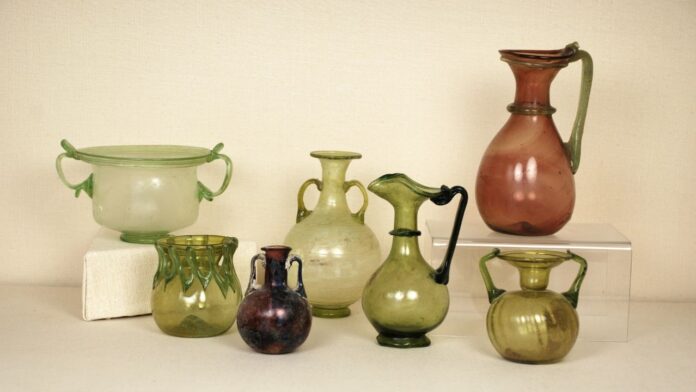Scientists claim that glass fragments from ancient Rome that have been buried for thousands of years have created crystals with complex applications in modern technology.
These ancient crystals can also be utilized to build lasers, filters, mirrors, and even anti-reflection stealth devices in current technology.
Researchers discovered that over generations, shards of broken glass reorganized and recombined with minerals to form photonic crystals, which may block certain wavelengths of light while allowing others to pass.
The research team from Tufts University’s Silklab in Massachusetts got the idea for their project after visiting the Italian Institute of Technology’s (IIT) Centre for Cultural Heritage Technology by coincidence.
“This beautiful sparkling piece of glass on the shelf drew our attention,” remarked Dr. Fiorenzo Omenetto, an engineering professor at Tufts University Silklab.
“It was a Roman glass fragment discovered near the ancient city of Aquileia, Italy.”
The center’s director, Dr. Arianna Traviglia, told Dr. Omenetto that her team jokingly referred to the device as “wow glass.”
The study team quickly concluded they were looking at photonic crystal natural nanofabrication. Additionally, you can also read about- Impacts of Technology in the Study of Statistics
“It’s really remarkable that you can have glass that has been sitting in the mud for two millennia and end up with something that is a textbook example of a nanophotonic component,” Dr. Omenetto said.
Chemical investigation dated the glass fragment to between the first and second centuries CE, with beginnings in Egyptian sands – proof of worldwide trade at the time.
The majority of the fragment’s original dark green color had been retained, but on its surface was a millimeter-thick patina with an almost perfect, mirror-like gold reflection.
Dr. Omenetto and Tufts colleague Dr. Giulia Guidetti used a novel type of scanning electron microscope that not only displays the material’s structure but also performs an elemental analysis.
“Basically, it’s an instrument that can tell you with high resolution what the material is made of and how the elements are put together,” Dr. Guidetti explained.
The patina was discovered to have a hierarchical structure composed of very uniform, micrometer-thick silica layers of alternating high and low density that resembled reflectors known as “Bragg stacks.”
Each Bragg stack strongly reflected different, relatively narrow wavelengths of light, with the vertical stacking of tens of Bragg stacks producing the patina’s golden mirror effect.
The research team argues that a procedure known as “corrosion and reconstruction” may have played out methodically over ages in assessing how the structure originated during a period of roughly 2,000 years.
“The surrounding clay and rain determined mineral diffusion and cyclical corrosion of the silica in the glass,” Dr. Guidetti explained.
“At the same time, 100 nanometer-thick layers combining silica and minerals were assembled in cycles.”
“The end result is an incredibly ordered arrangement of hundreds of layers of crystalline material.”
According to the research team, photonic crystals have a variety of uses in complex modern technology, such as lasers, filters, mirrors, and stealth devices constructed of anti-reflection material.
Dr. Omenetto went on to say that scientists may soon be able to grow optic materials in labs rather than producing them.
“While the age of the glass may be part of its charm,” he explained, “in this case, if we could significantly accelerate the process in the laboratory, we might find a way to grow optic materials rather than manufacture them.”
The molecular process of breakdown and reconstruction has some parallels with Rome’s everlasting city.
Read More: The Next Big Threat to Humanity: 15 Dangerous Technology
The ancient Romans were known for building long-lasting constructions such as aqueducts, highways, amphitheaters, and temples, with many of these structures forming the city’s topography.
The city grew in layers during the next centuries, with structures rising and falling in response to changes brought about by war, social turmoil, and the passage of time.
People utilised resources from shattered and abandoned ancient buildings for fresh construction during the Middle Ages.
However, in modern times, streets and buildings are frequently built directly on top of ancient foundations.
“The crystals grown on the surface of the glass are also a reflection of the changes in ground conditions that occurred as the city evolved: a record of its environmental history,” Dr. Guidetti explained.
The findings were published in the Proceedings of the National Academy of Sciences.
The article Ancient Roman glass could be utilised in modern technology first appeared on Talker.














![Technical Aspects of 844 Area Code in 2024 [Detail Guide] 844 Area Code](https://articleify.com/wp-content/uploads/2024/01/844-Area-Code-150x150.jpg)














